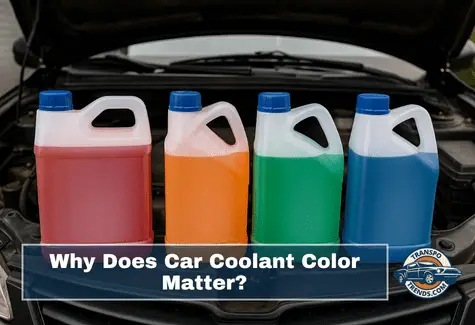Coolant, also known as antifreeze, is a crucial part of your car’s cooling system. It regulates engine temperature, prevents freezing, and protects metal components from corrosion.
While many drivers recognize coolant as the colorful fluid in their overflow tank or radiator, fewer understand why its color matters—and what it reveals about the chemical composition inside.
Coolant color is not just for visual appeal. It often signals the type of corrosion inhibitors used, which directly affects compatibility with your engine’s materials.
Using the wrong type—or mixing incompatible coolants—can reduce cooling performance, cause buildup inside the system, or even damage the engine.
This guide breaks down the significance of coolant color, the different types available, and how to make informed decisions that help maintain your car’s reliability and longevity.
The Function of Coolant in a Vehicle
Coolant serves multiple purposes beyond temperature regulation. It raises the boiling point of water to prevent overheating and lowers the freezing point to avoid damage in cold conditions.
In addition, it contains additives that inhibit rust, scale buildup, and electrolysis in the cooling system.
Coolant flows through key components like the engine block, cylinder head, radiator, heater core, and water pump. Because these parts are often made from different metals, coolant must be formulated with precise chemical additives to prevent galvanic corrosion.
Why Coolant Comes in Different Colors
The color of coolant is often used by manufacturers to distinguish between different chemical technologies.
While color is not a foolproof method for identifying coolant type, it is a helpful starting point. Most reputable manufacturers use standardized colors for specific formulations, though there are exceptions.
Using coolant with the correct chemistry ensures protection for the specific metals in your engine, compatibility with rubber hoses and seals, and optimal thermal performance.
Common Coolant Colors and Their Formulations
Below is a breakdown of the most frequently used coolant colors, their underlying technologies, and associated use cases.
Green Coolant – Inorganic Additive Technology (IAT)
- Chemical Composition: Ethylene glycol base with silicates and phosphates.
- Lifespan: Approximately 2 years or 30,000 miles.
- Compatibility: Ideal for older vehicles, particularly those built before the mid-1990s.
- Pros: Provides fast-acting corrosion protection.
- Cons: Short service life; incompatible with modern cooling systems that use aluminum and plastic components.
Pink or Orange Coolant – Organic Acid Technology (OAT) or Hybrid OAT (HOAT)
- Chemical Composition: Ethylene glycol base with organic acid corrosion inhibitors (OAT) or a hybrid of organic acids and silicates (HOAT).
- Lifespan: Up to 5 years or 150,000 miles.
- Compatibility: Designed for newer vehicles with aluminum engines and plastic radiators.
- Pros: Longer-lasting protection and better performance at high temperatures.
- Cons: Incompatible with IAT coolant unless the system is fully flushed.
Blue, Yellow, or Purple Coolants – Proprietary Variants
- Chemical Composition: Varies by manufacturer.
- Lifespan: Typically between 5 and 10 years, depending on the product and brand.
- Compatibility: Vehicle-specific. Blue coolant, for example, is used in some Japanese vehicles, while yellow and purple may be used in European or North American models with custom HOAT blends.
- Note: Always verify the formulation rather than relying solely on color. Brand-specific coolants may use unique additives.
Why the Color Matters for Maintenance and Engine Health
1. Indicates the Coolant’s Chemical Technology
Coolant color provides a visual cue about which corrosion inhibitors are present. For instance, green coolant contains inorganic additives like silicates and phosphates, while pink or orange coolant uses organic acids.
The difference in chemistry directly impacts compatibility with materials in the engine and cooling system. Using the wrong formulation can lead to scaling, reduced thermal efficiency, or accelerated wear.
2. Helps Prevent Accidental Mixing
Color-coding reduces the risk of mixing incompatible types. For example, topping off a system containing pink OAT coolant with green IAT coolant may lead to sludge formation due to a chemical reaction between silicates and organic acids. This sludge can clog radiator passages, heater cores, and coolant sensors.
According to Prestone UK, the consequences of mixing incompatible coolants can be “catastrophic” for the cooling system’s integrity.
3. Supports Warranty Compliance
Many manufacturers require specific coolant types to maintain warranty coverage. Using or mixing the incorrect coolant may violate warranty conditions, especially in newer vehicles where detailed service records are required.
Always check the owner’s manual and confirm the correct coolant before performing maintenance.
4. Ensures Proper Corrosion Protection
Modern engines rely heavily on lightweight aluminum parts that are more susceptible to corrosion. OAT and HOAT coolants are specifically designed to protect aluminum components, whereas older IAT formulas are better suited to engines with cast iron blocks.
Using an incompatible coolant type may compromise the protective film on metal surfaces, leading to pitting, leaks, or component failure.
Best Practices for Managing Coolant
- Consult Your Owner’s Manual: Always verify the correct coolant type and formulation before topping off or replacing coolant.
- Avoid Mixing Unless Chemically Compatible: Never assume different colored coolants are compatible. If in doubt, flush and refill with the recommended product.
- Use Distilled Water for Temporary Top-Ups: Tap water contains minerals that can damage the system. Distilled water is a safer alternative until proper coolant is available.
- Perform Scheduled Flushes: Replace coolant every 2 to 5 years, depending on the type and manufacturer’s guidance.
- Verify Claims for Universal Coolants: Use universal products only if they meet or exceed the specifications listed in your vehicle’s manual.
Summary Table: Coolant Types and Their Characteristics
| Coolant Color | Technology | Typical Lifespan | Compatible With | Mixing Concerns |
|---|---|---|---|---|
| Green | Inorganic Additive Tech (IAT) | ~2 years or 30,000 miles | Older vehicles (pre-1990s), iron radiators | Forms sludge when mixed with OAT/HOAT |
| Pink / Orange | Organic Acid Tech (OAT/HOAT) | ~5 years or 150,000 miles | Newer vehicles with aluminum/plastic parts | Incompatible with IAT without complete flush |
| Blue / Yellow / Purple | Proprietary HOAT/OAT Variants | 5–10 years (varies) | Specific makes (e.g., Nissan, GM, Ford) | Must match OEM formulation, cannot rely on color alone |
| Universal (Clear or Yellow-Green) | Multi-Platform Hybrid Blend | Up to 10 years or 300,000 miles | Some products meet OEM specs for all systems | Requires confirmation of OEM compatibility |

